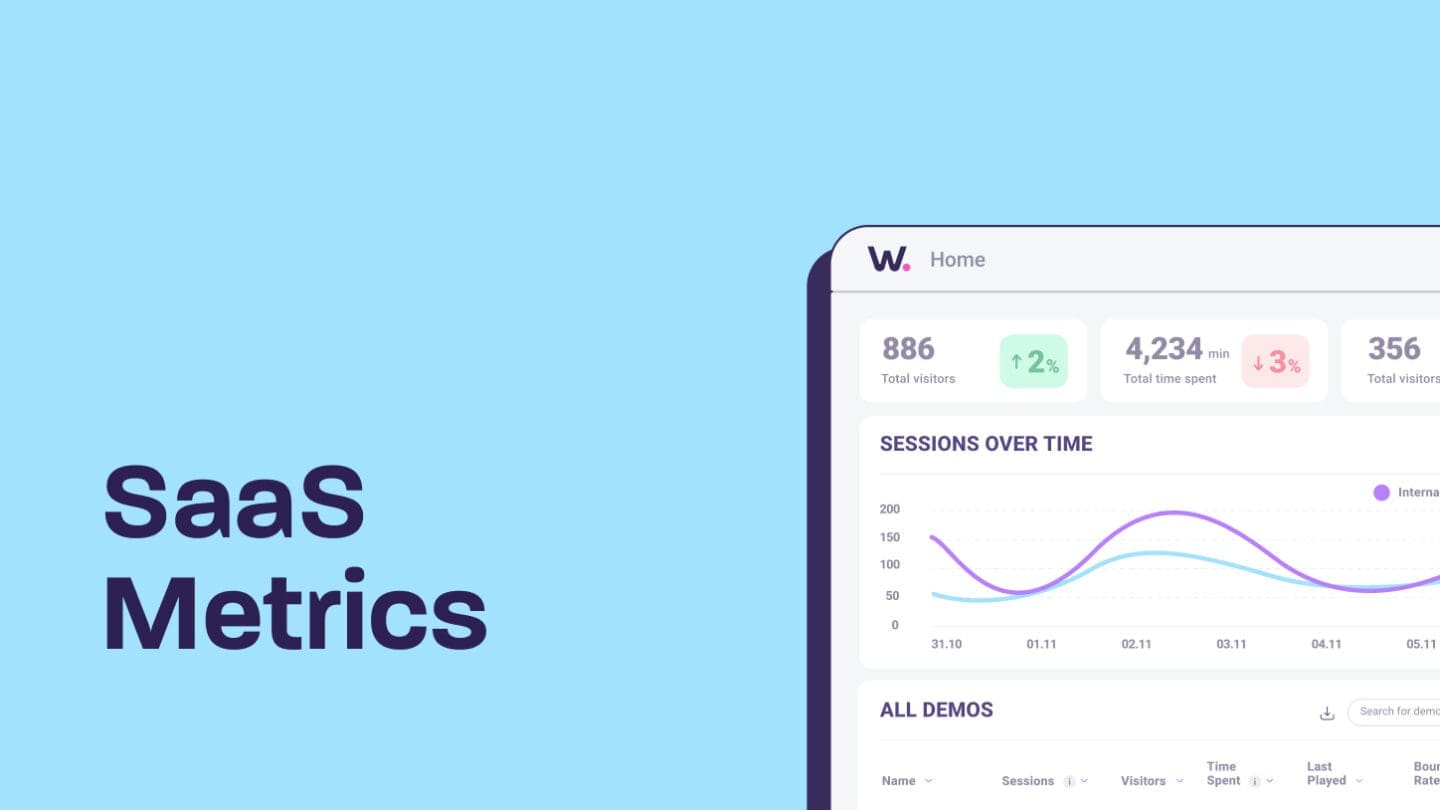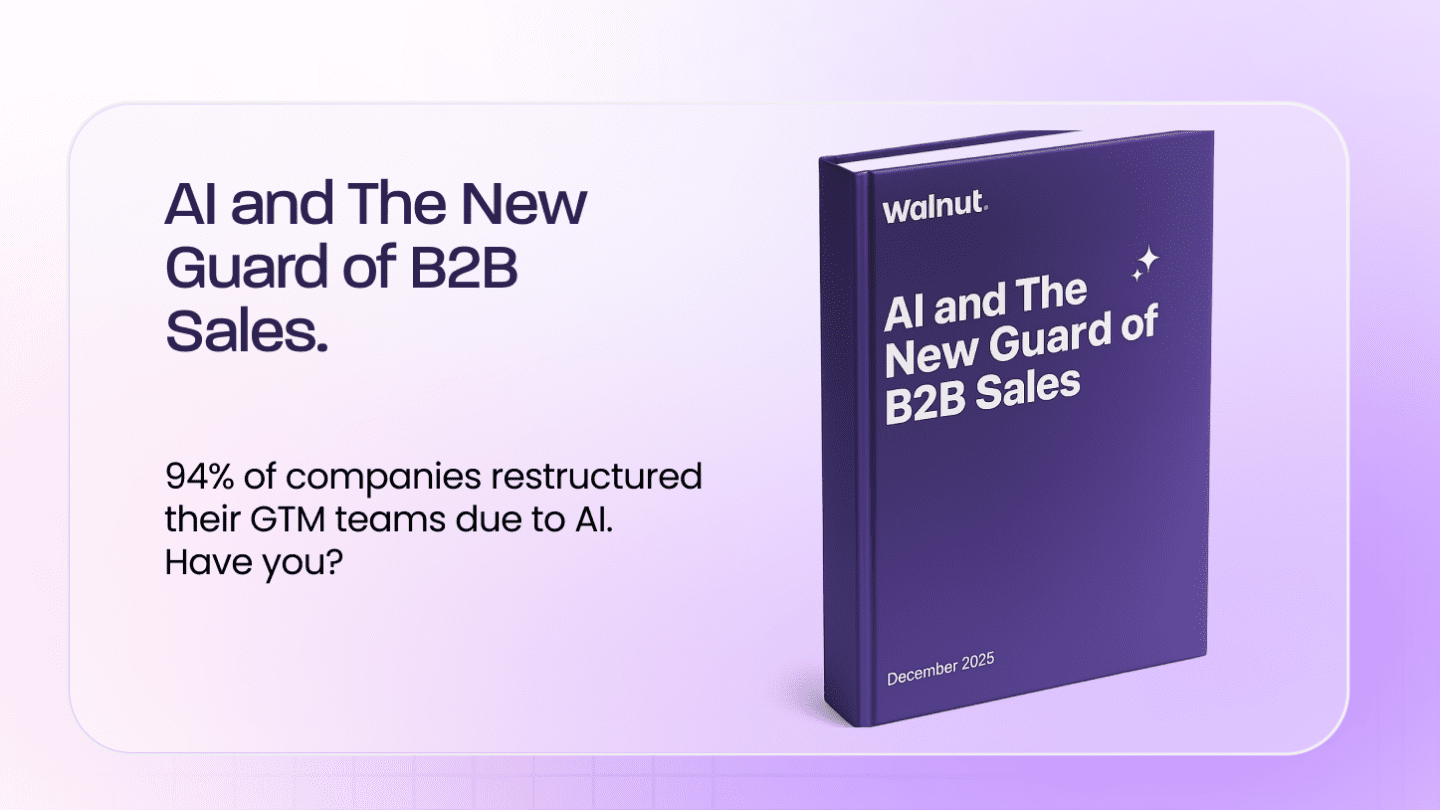Updated on April 17, 2024.
For many of us, when we hear that we need to calculate anything, traumatic childhood memories of math problems like this one immediately make us feel like we want to run for the hills. But tracking your SaaS sales metrics doesn’t need to be overwhelming.
We’re here to help break it down for you step by step, so you can do what you need to do for your company.
Why tracking and analyzing SaaS Sales Metrics are important
Software as a Service (SaaS) companies must react quickly to survive in a market that is becoming increasingly cutthroat. Because your competitors can iterate and develop their tech rapidly, the saying “adapt or die” is becoming more relevant than ever.
But, it’s not just a race to develop for the sake of it; you need to effectively plan your growth, know what to develop, when, and why. You need to understand your customers, their needs, the cash flow you have at your disposal, and how you can consistently provide buyers with the best service possible.
The solution? Tracking and analyzing your SaaS sales metrics.
But if you’re not using up-to-date analytics or if you don’t understand your sales data, any changes you make to your processes, resources, products, or services will be a stab in the dark. You need to analyze your numbers to make data-driven decisions.
By properly tracking and analyzing your sales data, you can:
- Make decisions based on data, not guesswork.
This means you’ll consistently lean into what works and away from what doesn’t. - Find your most profitable product or service.
You can also learn the segment of customers that are the most profitable for your SaaS. - Analyze seasonal or external forces in demand.
This can help you prepare for future peaks and troughs. - Understand what your customers like or dislike about your product.
Double-down on what’s working and ditch anything that’s not adding real value. - Locate potential gaps in your existing customers.
Grow your business by finding an untapped market for your offering. - Evaluate your team’s performance.
This data will help with your sales capacity planning.
Understanding your core SaaS sales metrics will help you find and maintain product-market fit. Because if you don’t, someone else will.
8 SaaS sales metrics you need to track and how to calculate them
We won’t bombard you with the dozens, if not hundreds, of SaaS metrics that you can track. Because unless your budget and resources are infinite, the smart move is to track the most important ones—and track them well.
By keeping an eye on these 8 core metrics, you’ll be able to foresee any potential problems, identify opportunities, and fill gaps in your offering.
1. Monthly recurring revenue (MRR)
If you want to grow your business and manage your revenue, the first thing you’ll need to understand is how much money you’re bringing in per month. That’s where your MRR comes in.
Most SaaS companies charge monthly for their services. That’s why it’s important to look at the revenue data that comes in every month. Keeping track of your MRR allows you to make accurate measurements about cash flow health, help forecast growth, and plan your budget. If you know how much you earn on average per month, it makes it easier to gauge how much you should be spending per month in other areas of your business.
How to calculate your MRR
To calculate your MRR, multiply the average revenue per user (ARPU) by the number of monthly subscribers.
For example, if you have 10 customers on your $1,000 per month plan, your MRR will be: 10 x $1,000 = $10,000.
MRR formula: (ARPU) x (Number of monthly subscribers)
2. Customer churn rate
Sometimes in business, we can get caught up on building relationships with our new, exciting customers and forget how important retaining our older customers is. That’s why this metric is here to keep you laser-focused.
Your churn rate allows you to measure how much business you have lost over the course of a set period. Using this data analysis, you can identify how much your customers love your product overall and, if necessary, work on minimizing mistakes in your customer onboarding and retention strategies.
Be sure to refine your SaaS churn rate metrics to consider personas, industries, and location. This will help you gain a greater insight into the implications of your retention decisions and give clues as to what needs to be altered.
How to calculate your customer churn rate
To calculate your customer churn rate, take the number of customers you lost in a month and divide it by your total customers at the start of the month. Then multiply it by 100.
For instance, if you have 150 customers at the beginning of January and only 140 of those are still paying at the end of the month, you’ll subtract 140 from 150, which will give you the number of customers who churned, i.e. 10. Then you’ll divide the customers you lost by your initial number of customers (10 ÷ 150 = .05) and then multiply it by 100, which should give you a total of 6.6.
This means your customer churn rate for the month of January was 6.6%, which is slightly higher than the average B2B SaaS churn rate of 4.79%
Churn rate formula: (Number of customers you lost in the month ÷ Number of customers at the start of the month) x 100
3. Revenue churn rate
But knowing the percentage of customers who left you is just the start. Take it a step further to understand what this customer churn is costing you in revenue.
That’ll help you understand the type of customers who are leaving. If your customer churn rate is high, but your revenue churn rate is low, you’ll know that your issues lie in retaining your smaller customers. Likewise, if your customer churn is low but your revenue churn rate is high, you have a problem retaining your higher paying customers.
Having multiple metrics to gauge your churn will help your business more efficiently take stock of its customer retention.
How to calculate your revenue churn rate
To determine the amount of revenue that churned, divide the MMR you lost in the month with your total MMR at the start of the month.
For example, if your company has a $50,000 MRR at the beginning of January, but only $40,000 MRR at the end, you lost $10,000 MRR. You would then divide your lost MRR ($10,000) by the amount you started with ($50,000) and then multiply by 100. Your equation should look like this: 10,000 ÷ 50,000 = .2 x 100 = 20% revenue churn.
Revenue churn rate formula: (MRR lost in a month ÷ Total MRR at the start of the month) x 100
4. Annual recurring revenue (ARR)
Similar to your MRR, which calculates your recurring revenue per month, your annual recurring revenue (ARR) metric tracks your recurring income over a year.
Finding your ARR is straightforward, but don’t undermine its power. Because of its broader timespan, your ARR can be a significant indicator of your company’s performance over long periods of time. By tracking your ARR, you can better monitor your company’s growth year-to-year to measure its progress.
How to calculate your ARR
To calculate your ARR of a specific customer, divide the total contract value by the number of years of the agreement.
For example, if you sold a 2-year subscription for $12,000, the ARR for this deal would be $6,000 because $12,000 ÷ 2 year agreement = $6,000.
ARR formula: Total amount of the deal ÷ Number of years
5. Customer acquisition cost (CAC)
If you want your business to grow, you definitely need to be consistently bringing in new customers. But what are you willing to spend to get one?
Your customer acquisition cost (CAC) metric tracks the average price you pay to gain a new customer. Usually, this will include the money you spent on acquisition, marketing, and sales.
Keeping an eye on this metric is useful to track the effectiveness of your marketing and sales efforts and to make sure you’re seeing the results you want from your outreach.
How to calculate your CAC
To calculate your customer acquisition costs, you’ll first need to add up all the costs of acquiring new customers that you spend throughout a certain amount of time. This can include your marketing staff, campaigns, ads, sales reps, sales support materials, product demos, and more.
You’ll then divide the results by the number of customers acquired over that time.
For example, if you’re spending $30,000 on marketing per year and, at the same time, manage to acquire 120 new customers, your calculation should look like this: 30,000 ÷ 120 = 250. Thus, you’re spending an average of $250 per new customer, which is slightly below the average spent by B2B SaaS companies.
CAC formula: Total costs of acquiring new customers ÷ Number of customers acquired
6. Customer lifetime value (CLV)
How can we possibly put a price on how much our customers mean to us? Well, by tracking your CLV, you actually can.
Your customer lifetime value measures the amount of money a specific customer (or an average customer) will pay your company during their lifecycle with you. With this metric, businesses can gain useful insights that can help them create pricing plans, optimize buyer retention, and determine how much they can afford to spend on acquiring new customers.
Plus, once you analyze your customers’ lifetime values, you can categorize your results based on company size, vertical, and any other appropriate indicators. This will help you determine which types of customers spend the most and are the most valuable to your company.
How to calculate your CLV
To determine CLV, you’ll first need to calculate the total revenue you’ll earn from a specific customer (or your average customer). You can do this by multiplying the annual recurring revenue by the number of years you expect them to use your SaaS product.
You’ll then subtract the customer acquisition costs to find your CLV.
So let’s say your average client pays $100 for a yearly subscription to your SaaS product and the average user pays for your product for 5 years. Meanwhile, your CAC costs are around $250.
First, you’ll multiply $100 by 5 and then subtract $250. This means your average CLV is $250.
CLV formula: (ARR x Average length of contract in years) – CAC
7. Months to recover CAC
You spent all this money acquiring a new customer. But how long will it take until your company makes that money back?
This is an important question to answer so that you can make sure your CAC is not too high and allows you to understand how long your customers must stay active with your SaaS to begin seeing a return on investment (ROI).
How to calculate your months to recover CAC
First, make sure you have your updated CAC, the average amount of revenue you earn per customer, and the percentage of the revenue that is your gross profit. Next, multiply the revenue by your gross profit percentage. Then, divide your CAC by that number.
In others words, you need to divide the cost to acquire a customer by the average revenue per account multiplied by the gross margin as a percentage. This calculation gives you the number of months it takes to recover CAC.
Let’s use an example to make this clear. Let’s say your Saas business acquires customers for $200 each, your average revenue per account is $50, and you have a 50% gross margin. So here’s what you’ll calculate: $200 ÷ (50 X 0.5) = 8 months to recover your CAC
Months to recover CAC formula: Cost of acquisition ÷ (Gross margin x Average revenue per account)
8. Lead velocity rate (LVR)
If you want to understand how quickly your sales are growing (which you absolutely should want to know), then you’ll need to be introduced to this key metric.
Your lead velocity rate measures the real-time growth of qualified leads generated by your company month to month and is indicative of your business’s long-term growth. Unlike other revenue-related metrics that fluctuate, LVR enables you to see whether your qualified leads are increasing, a sign of future, and almost guaranteed business growth.
How to calculate your LVR
To calculate LVR, first subtract the number of leads you gathered last month from the number of leads you gathered this month. That’ll give you the number of extra leads you generated this month compared to the one before. Then divide that number by the number of leads you generated last month. Last, multiply your answer by 100.
For example, if 250 qualified leads came in this month and 200 leads came in last month, here’s what you’ll do: (This month’s leads) 250 – Last month’s leads) 200 = 50. (Additional leads this month) 50 ÷ (Last month’s leads) 200 = .25 x 100 = 25. So your LVR is 25%.
LVR formula: (Qualified leads this month – Qualified leads from last month) ÷ Qualified leads from last month x 100
Sales data analysis methods you need to start using
Do you have your calculator ready?
Because we’re about to crunch some numbers.
As a SaaS company, it’s essential to understand the difference between the different analysis methods and choose the best one for your specific use case or performance insight.
Here’s a rundown of the most common sales analysis methods:
Sales trend analysis
How have your sales changed over the last quarter? What about this past December compared to the December of last year?
Tracking your sales trends over short or long periods allows you to understand your product demand and helps you progress towards reaching your revenue KPIs.
How to track it:
To conduct a sales trend analysis, use your CRM or invoicing software to gather all the sales records. Then compare the data month to month or year to year to gain a better understanding of the trends over time.
You can also use that information to narrow down the trends by your products, regions, customers, channels, contracts, product type, contract type, and so on.
Enter the data into Excel or Google sheets to calculate your trends over time.
Sales performance analysis
How’s your team performing? Are your campaigns hitting the goals they set out to achieve?
Your sales performance analysis can help you track these important metrics. Compare the revenue generated by each sales rep, team, department, or campaign, to your business goals.
How to track it:
To conduct a sales performance analysis, use your CRM to determine the revenue generated by each agent.
Then enter the data into a spreadsheet and crunch the sales and revenue generated by team, department, and campaign.
Predictive sales analysis
How much can you expect to sell next holiday season?
Your predictive sales analysis can help you estimate future demand for your product (or lack thereof). SaaS companies should use their historical data to model future predictions for sales, identify opportunities for increasing revenue, and prepare for any potential risks.
How to track it:
To conduct predictive sales analysis, you need to find your historical sales data in your CRM or pipeline software. It’s essential to ensure this data is clean and accurate before moving on to the analysis.
While you may be able to gather all this data manually, it’s pretty complicated and most companies choose to use tools that enable AI and machine learning to analyze the data and make forecasts.
Sales pipeline analysis
What’s it like to be a customer of your company? What’s your customers’ buying experience?
You can learn a lot about this by tracking your pipeline data. Gain insights into your customer’s journey from cold or inbound lead through the various stages to either a drop-off or a closed deal.
Analyzing this can help you learn at what stage you are losing leads, how long the process takes, and how many touchpoints you need on average.
You can then optimize your funnel and marketing collateral to ensure the leads are getting the right information at the right time, reduce drop-offs, increase speed to sale, and ultimately, improve conversion rates.
How to track it:
The first step of your sales pipeline analysis is to set stages in your CRM’s pipeline that can be used by the entire team. Next, you need a set of guidelines to ensure that your reps are using the same sales metrics to determine that a lead should be moved to the next stage of your pipeline.
Finally, decide on a set of core SaaS sales metrics to analyze the pipeline. We recommend:
- New marketing qualified leads (MQLs) per week/month
- Conversion rates per pipeline stage
- Pipeline value per stage
- Overall pipeline value/sales cycle (to give you an idea of the daily value of your pipe)
- Sales rep performance
Product sales analysis
What are your different offerings and are you making enough money on each? Which is your best seller? Are your prices high enough?
These are important questions and the best way to solve them is by analyzing your product sales data.
You may have various SaaS products or different plans that customers can choose. You likely have an enterprise-level product or a stripped-back version for smaller businesses. But regardless of the products you have, it’s important to analyze the performance of each one, as well as the resources required to develop, maintain, and sell them.
Once you start tracking this, you might uncover that one product sells well, but its profit is minimal due to higher maintenance or more demanding customer service.
How to track it:
Use your invoicing software or CRM to determine the volume of sales per product by day, week, and month.
Then, uncover the cost to deliver each product. For example, in the SaaS world, this could be the costs of development, onboarding, and customer service time.
In a spreadsheet, analyze the profit and loss for each product, as well as the sales over time. This will help you find the profit per product and the speed of sales for each product.
Gain more data and insights from your demos
Sales demos are arguably the most important element of your sales process. The demo is where your prospect gets the chance to see your product for themselves and understand how it works and how it can solve their pain points.
But how can you track insights from this stage and optimize the experience?
Glad you asked.
When you use Walnut to create personalized, interactive product demos, you can gain powerful insights into your prospects by tracking your demo metrics.
Gain information about how your prospects use your demo, who they share it with, and their overall engagement. Then, continue to optimize your demos based on their performance and the number of conversions they accrue.





